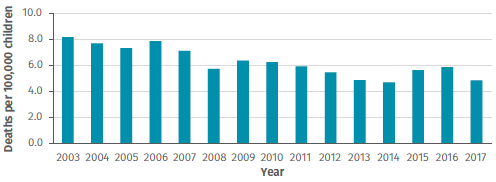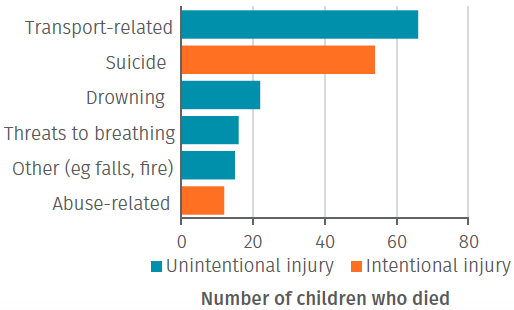
Deaths of children in NSW in 2016 and 2017: injury
In 2016 and 2017, 185 children aged 0-17 years died as a result of injury. This represents one fifth of all children who died in NSW over the same period, a mortality rate of 5.3 deaths per 100,000 children.
As shown in Table 1, more than two thirds of the children who died from injury were male. Young people aged 15-17 years accounted for almost half the injury-related deaths. Aboriginal and Torres Strait Islander children were over-represented. Almost a third of children were living in the most disadvantaged areas in NSW.
| Number | % | |
|---|---|---|
| Gender | ||
| Female | 60 | 32% |
| Male | 125 | 68% |
| Age | ||
| Infants (under 1 year) | 17 | 9% |
| 1 - 4 years | 37 | 20% |
| 5 - 9 years | 15 | 8% |
| 10 -14 years | 33 | 18% |
| 15 - 17 years | 83 | 45% |
| Aboriginal and Torres Strait Islander | ||
| Aboriginal and Torres Strait Islander | 24 | 13% |
| Non-indigenous | 161 | 87% |
| Remoteness | ||
| Major cities | 102 | 55% |
| Regional areas | 79 | 43% |
| Remote areas | 3 | 2% |
| Socioeconomic status | ||
| Quintile 5 (least disadvantaged) | 19 | 10% |
| Quintile 4 | 23 | 12% |
| Quintile 3 | 40 | 22% |
| Quintile 2 | 48 | 26% |
| Quintile 1 (most disadvantaged) | 53 | 29% |
| Total | 185 | 100% |
Trends in mortality
Over the 15 years to 2017, the injury mortality rate has significantly declined from 8.2 to 4.8 deaths per 100,000 children (Figure 1).
Figure 1: Children who died from injury, 2003-17

Young people aged 15-17 years have the highest injury mortality rate, followed by infants. The rate has remained significantly higher for males compared with females, and for Aboriginal and Torres Strait Islander children than for non-Indigenous children.
In the five-year period 2013-17, the mortality rate for injury was more than four times higher for children in remote areas than for children in major cities. The rate for children from the most disadvantaged areas was more than double that of children from the least disadvantaged areas.
Leading causes of injury-related death
Transport incidents were the leading cause of injury-related death for children overall (Figure 2).
Figure 2: Causes of death due to injury, 2016 and 2017

Suicide was the leading cause of death from injury for children aged 10-17 years.
Drowning was the most common cause of death from injury for children aged 1-4 years.
Accidental suffocation (threats to breathing) was the leading cause of death from injury for infants.
Trends in injury-related causes of death
Transport-related injury
The mortality rate for transport incidents has not changed significantly from 2008. Over the 15 years to 2017, males aged 15-17 years who were drivers of vehicles accounted for most of these deaths.
In the five-years 2013-17, the rate was:
- 3.9 times higher for children from the most disadvantaged areas as for those in the least disadvantaged areas.
- 2.5 times higher for children from remote
areas than those in regional areas, and 6.8 times higher than those from major cities. - 2.4 times higher for Aboriginal and Torres Strait Islander children than for non-Indigenous children.
Over the last 15 years, the nature of transport-related injuries has changed. The rate of children who died as passengers in vehicles declined by almost two thirds. The rate of children who died as pedestrians declined by half. The rate has not changed for children who were drivers of vehicles including cars, quadbikes, and motorcycles.
Key observations for transport-related injury
- Unsafe driver behaviours remain key contributing factors in transport crashes.
- Novice drivers made up the majority of at-fault drivers responsible for collisions.
- Young drivers tend to drive older, less safe vehicles.
- Better use of seatbelts and child restraints will prevent the deaths of children in vehicles crashes.
- At least two children die each year in low-speed vehicle run-over incidents.
- Quad bikes are inherently dangerous for children.
Drowning
From 2011, the mortality rate for drowning has steadily declined. In 2016, the rate increased, before declining again to 0.4 deaths per 100,000 children in 2017 – the lowest rate in 15 years.
Over the 15 years to 2017, children under five years old accounted for two thirds of drowning deaths. In the most recent five-year period (2013-17), the rate was:
- 5.2 times higher for children under five years as for those aged five years and above
- 2.4 times higher for males than for females
- 2.2 times higher for children from regional areas than those from major cities.
Over the last 15 years, almost half of all drowning deaths occurred in private swimming pools. Private swimming pools accounted for the majority of drowning deaths of children aged under five years. For children aged five years and above, most drowning deaths occurred in natural bodies of water.
Key observations for drowning
- Only one private swimming pool in which a child drowned was compliant with child safety barrier fencing requirements.
- It is not clear how effective the inspection regime is in NSW. The majority of local councils do not report complete information about swimming pool inspections.
- Carer supervision is a critical protective factor, including at public swimming pools.
- Carers should be aware of drowning hazards for young children such as fishponds, dams, canals and household water containers.
Suicide
The mortality rate for suicide has continued to increase significantly since 2003. The rate in 2017 was the highest observed in the 15 years at 3.8 deaths per 100,000 young people aged 10-17 years.
Over the 15-year period, two thirds of the young people who died were male. Young people aged 15-17 years accounted for 80% of deaths.
Over the five-years 2013-17, the mortality rate for suicide was:
- 3.1 times as high for Aboriginal and Torres Strait Islander young people than for non-Indigenous young people
- 1.6 times higher for males than for females
Key observations for suicide
- There is no focused suicide prevention plan for young people in NSW.
- Identification of suicide risk in young people must be supported by effective strategies to manage and contain risk.
- Suicide prevention and intervention strategies should be subject to ongoing monitoring and evaluation.
- Agency review of involvement with, and response to, young people who die by suicide should inform better responses.
Abuse and neglect-related deaths
Over the 10-year period from 2008, 118 children have died in circumstances of abuse or neglect in NSW. Two thirds of these deaths were homicides. The remaining deaths occurred in neglect-related or suspicious circumstances.
Very young children were most vulnerable to fatal abuse and neglect, with children under five years accounting for more than half of all abuse and neglect-related deaths.
Male children are over-represented in abuse and neglect-related deaths. One in five children who died were Indigenous. Over half the families of children who died in circumstances of abuse and neglect had a child protection history.
Key observations for abuse and neglect
- Risk was not consistently recognised or responded to by the child protection system.
- Mental health services need to ensure that the treatment and support of parents with mental illness is provided within the context of the adult’s parenting and family responsibilities.
This page contains key information from the Biennial Report of the deaths of children in New South Wales: 2016 and 2017.
Contact us for more information
Our business hours are: Monday to Friday, 9am–5pm (Inquiries section closes at 4pm)
If you wish to visit us, we prefer you make an appointment. Please call us first to ensure your complaint is within our jurisdiction and our staff are available to see you.
NSW Child Death Review Team
NSW Ombudsman
Level 24, 580 George Street
Sydney NSW 2000
Email cdrt@ombo.nsw.gov.au
General inquiries 02 9286 1000 Toll free (outside Sydney metro) 1800 451 524
National Relay Service 133 677
Telephone Interpreter Service (TIS): 131 450
We can arrange an interpreter through TIS or you can contact TIS yourself before speaking to us.
© State of New South Wales, June 2019
This publication is released under a Creative Commons license CC BY 4.0.
Publication metadata
| ISBN | 978-1-925885-09-5 |
|---|---|
| Category | Fact sheets |
| Publication Date | 25 June 2019 |
